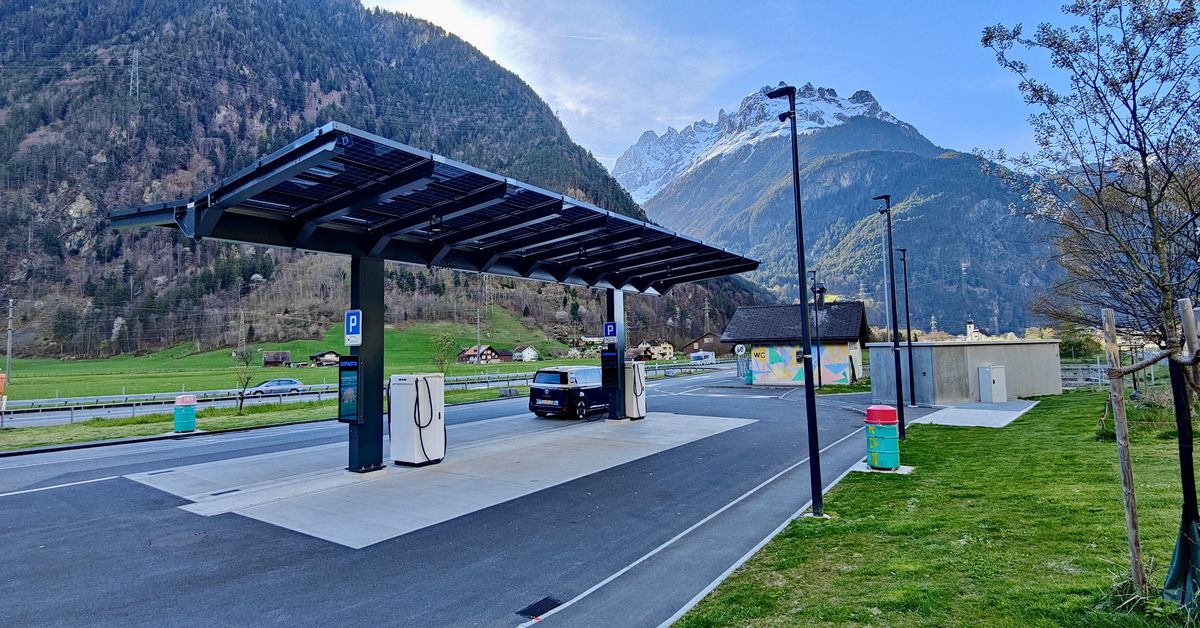Sometimes, I dream that at least half of the same effort was made for public transport between densely populated areas
Does anyone know what the status is on the electryfying roads in Europe? Like they’ll do in Sweden (permanent electric road
patented technology […] transmits up to 300kW of power to the vehicle through a retractable pick-up that drags along a metal rail embedded in the road.
Interesting. So that would be one lane on only?
One of the biggest issue right now is diversification. If we (try to) establish various different loading technologies will we only be able to use one in some places? Will we be able to use and need various adapters? Will we have to adjust our vehicles eventually with a tech switch?
We’re still in a diversification stage. Hopefully we’ll arrive in a consolidation phase soon, or a more structured focused international approach.
We’re still in a diversification stage. Hopefully we’ll arrive in a consolidation phase soon, or a more structured focused international approach.
We shall see which system will come out best, maybe several. I do like the electryfying road for charge up
I’m not an expert or anything, but my masters was focused on driving technology, and specifically the intersection of technology and sociology. A conclusion I often felt drawn to is that, while humans are still the drivers, the technology will always lack efficiency.
Charging highway is a neat idea but having it shared between vehicles like trucks which try to travel a consistent speed, and cars which change lanes etc, means that I think the human factor will complicate the process (and safety) to a high degree.
There are a great many advancements we can make to automotive technology if we reduce our reliance on a human driver.
For sure, the human/ machine interface is leading. Sometimes humans adapt, and at other times it’s the machine that needs to change. Especially in these cases the question is what or who defines efficiency. Some might say (human) need, comfort & accessibility.
I’m a bit skeptical about it really working on large scales during summer holidays. Aren’t EV supposed to charge for at least 30 minutes 1 hour minimum to be able to get some autonomy? How is that realistic with such a high number of vehicles?
I’m on vacation with a rented Tesla Y LR in Tuscany right now. We traveled all the way from northern Germany (about 1500 km) and never had any issues finding a free charging station. Just once every single parking spot was used and the charging automatically stopped at 80% in order to make space for others more quickly (and to be honest, this was due to other cars parking in the Tesla reserved parking spots at an Italian supermarket).
Traveling with kids automatically makes you take a break every 3 hours or so. This time, we just let the car charge during these breaks and had a 100% charged car afterwards. That’s about 55 min of charging time. In about 25 min you can charge from 20% to 80% using a 250 kW supercharger.
You have to keep in mind that long distance travel is not the usual use case and that being able to slowly charge the vehicle during the night is also important. Most camping sites, hotels and vacation resorts offer at least two 11 kW stations at their own rates.
right now
That’s the key phrase. Consider a regular gas station where cars constantly come and go. Now, imagine if in 10 years we’ll have a similar demand for EV charging stations. I can’t see that working well with the current batteries. Solid-state batteries are not available yet and there’s no guarantee that they’ll hit the market anytime soon.
You realize you can put “electricity pumps” in any retail parking spot, right?
Putting in a gas station is a horrifyingly complex infastructure demand. Slapping 2-4 chargers in literally every retail parking lot is simple in comparison.
No, you can’t. Adding a large number of EV chargers requires a significant upgrade to the electrical grid. This is a massive infrastructure challenge. Charging an electric vehicle consumes a large amount of electricity, and the current electrical grid may not be equipped to handle a significant increase in demand. This could lead to overloads and blackouts.
Unlike refueling a car with gasoline, charging an electric vehicle takes a significant amount of time. Even with fast chargers, a full charge can take more than an hour. This would mean that you wouldn’t be able to put nearest gas station in your Waze, you might need to cruise around an unknown city, looking for a free spot.
The cost of installing EV charging stations is significant, and it’s not clear who should bear this cost. Should it be the government, property owners, or the consumers? Additionally, the maintenance and repair of these charging stations are not negligible.
If the electricity used to charge the vehicles is not generated from renewable sources, then the overall environmental impact could still be significant as well as impact on the electricity prices.
There is a lot one should consider before writing witty replies.
A lot of generalization and supposition in the above.
Adding charging stations may require grid upgrades, but its a slow and steady requirement you can do neighborhood by neighborhood. Depending on the neighborhood, it may not be required, be minor, or be massive. It all depends. Making sweeping generalization about power generation, a deeply localized utilty, is a poor choice.
In my locality and most of my state, a large amount of charging spots are going up in front of common retailers with no clear utilty work. Our grid is currently fully able to bear the added load.
As to who pays for it, the current system seems to work, and will only improve as more cars go electric. The most effective method seems to be a mesh of private/public investment. Public for grid sizing, power supply and sometimes space for the charger. Private cost of wholesale power, charger install and maintenance, interoperability and paymebt processing. The Private entity takes the gross profits in the above, paying for power and any split with other private entities. The public has its costs covered and has a net positive public good added.
It is not that complicated to install charging infastructure 2 chargers at a time. It seems pretty apparent that retail spaces at least in the US are over built powerwise, and can largely handle the addition. Its why many grocery stores have them popping up suddenly in urban areas.
As to the cleanliness of energy, one large pollution provider is overall more environmentally friendly than millions of small ones. They can also be regulated and inspected in a way millions of small ones cannot be. Centralized generation of power for cars via electricity, of any source, will be greener than millions of cars burning gasoline. Always. Shifting the load to renewables as well is the right answer, but any shift here is good.
Stop saying this is a “massive infastructure challenge” when its actually a small and steady challenge occuring thousands of times. Small things done over and is the massive part, and they are very doable today, in the US and the EU.








